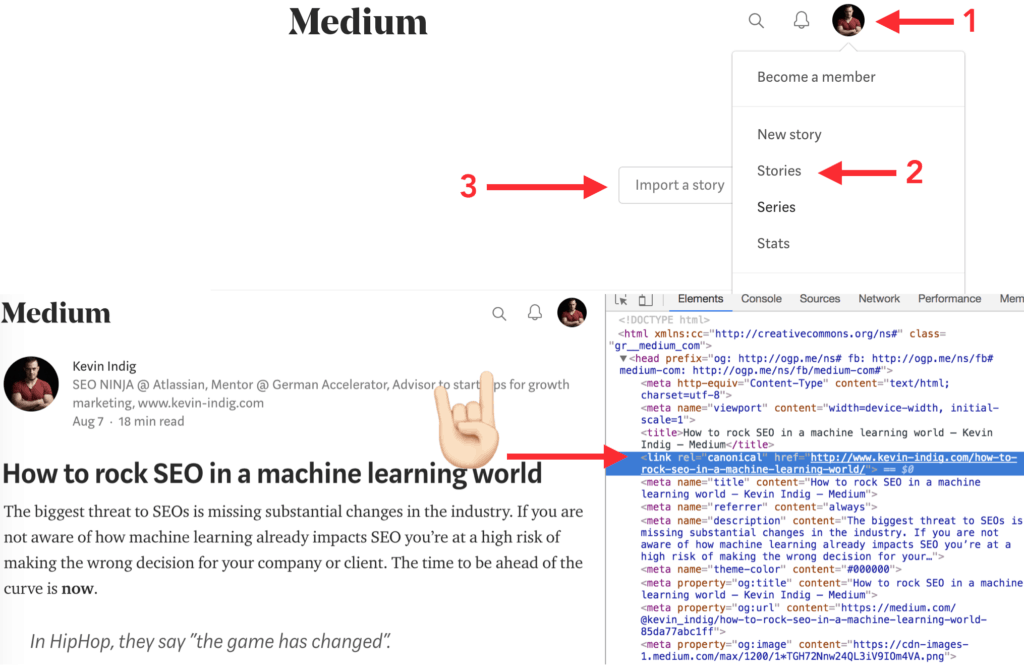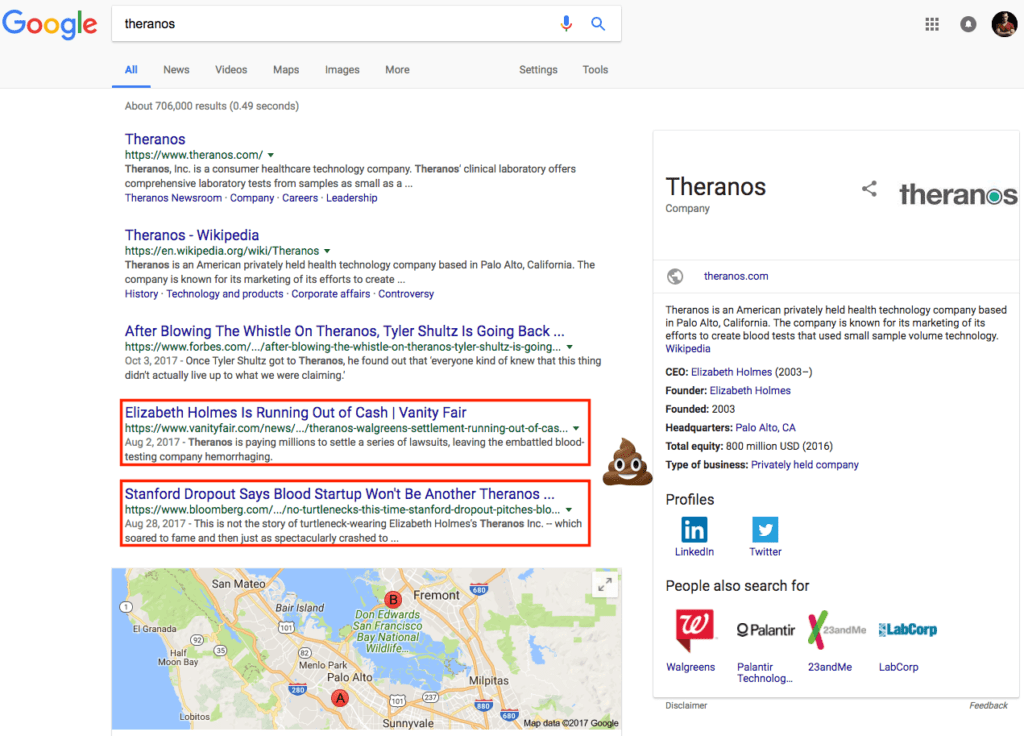The SEO mistakes young startups make every time
As a startup mentor at the German Accelerator, I see young startups make the same SEO mistakes over and over again. Here are the top 5 SEO mistakes and how to do it better.
As a startup mentor at the German Accelerator, I see young startups make the same SEO mistakes over and over again.
Especially when nobody knows you and you’re trying to make a name for yourself, it’s important not to waste your efforts.
Without further ado, here’s what you should not do:
1. Using Medium as a preferred blogging platform
The most important goal to accomplish for a new brand is to build “domain authority”. You want Google to recognize your brand as a brand and not another “word”.
That’s even more important when your startup’s name is “generic”, like “Apple”. Google knows that when people search for “apple”, they want the brand, not the fruit.
And you get a nice knowledge graph integration (on the right), besides your domain showing up on top. But that took quite some time for Google to figure out.
Another example is “roman”, a new startup on the scene. Google thinks people want information about the Roman Empire when looking for that brand.
You only see the latest news about the startup (1st article), but what if you’re going through a phase without media buzz? The domain doesn’t show up on top. Not even in the top 10 search results for the keyword “roman”.
So, the question is how to signal to Google that you’re a brand and not a fruit or an ancient empire. And one of the most important factors is backlinks.
You don’t want to find a way to “automate” link building. Ask thumbtack. Or rapgenius. You want links to come up naturally.
One of the best ways to do that is by blogging. And that’s where we close the loop to Medium.
Yes, Medium is easy to use.
Yes, the Medium community is big.
It’s attractive to go for the easy solution, but when your blog is on Medium, you get no link power to your domain. Links to other sites are automatically set to “nofollow”, so search engines won’t follow them, and they will pass no link power.
Plus, you don't get a lot of data about your users. And you can’t put your medium blog in a subdirectory of your domain (e.g., www.apple.com/blog vs. blog.apple.com), which is another SEO problem.
So, what should you do instead?
You can also just watch this video if that’s easier for you.
Host your blog on WordPress (in a subdirectory, not on a subdomain) and use Medium's import function (click on your profile pic, "stories", "import a story").
This will allow you to import any article and get a canonical tag to your original blog post.
This way, you can leverage the Medium community AND get organic traffic from Google!
2. Not keeping backlinks in check
Another way to mess up your visibility in organic search is to not leverage the opportunities you get when you start out.
There are a lot of startup platforms on which you can create a profile, like Angellist, Producthunt, Hackernews, Crunchbase, Indiehackers, … you name it!
Those sites are valuable reputation management assets! They help you acquire initial users and potential investors.
Say someone had only two eggs for breakfast instead of three and writes a negative article about your startup that starts to rank for your brand.
In this case, you want pages on strong sites that rank for your brand to push the negative article down. Well-maintained profiles on the mentioned sites and social networks help you with that.
But they also give you some initial link power when your brand is still "new to Google".
However, most startups mess this one up badly.
For example, let’s look at the blockchain startup “ConsenSys” (#sorrynotsorry). On Angellist, the link to their website is ConsenSys.net (looks stylish, doesn’t it?).
But, when you look under the hood, this leads to a chain of quirky redirects to the final destination, https://consensys.net/.
In the process, they lose all the link power this link would have given them.
So, what should you do instead?
When you set up your profile, make sure you set the link to your homepage and use the correct domain. https://www.domain.com vs domain.com vs www.domain.com makes a difference!
Make sure only one version of your homepage is available (if you're on https you shouldn't be able to go to http://domain.com, for example). Redirect http://domain.com to www.domain.com if that’s the address you want to use.
And please don’t try to be “cool” by using some funky way to write your domain name #wWw.D0mA!n.com.
3. Exclusively blogging about thought leadership
Thought leadership is cool, and people like to share that stuff, but when nobody knows you, you’re missing the “leadership” in “thought leadership”.
If you start out and exclusively blog about thought leadership, you'll have a hard time getting a lot of organic traffic.
Unless you're Elon.
So, what should you do instead?
Educate your audience and be helpful! Use your unique data to create kick-ass content that's entertaining, interesting and useful. Don't push your product too much.
Buffer is a social media tool and kills it at content marketing.
Their articles are shared like crazy, get tons of engagement and help (potential) customers use their products at the same time!
“Into the Gloss” is another example…
… or Leadpages’ blog.
Jab, jab, jab, right hook.
That will get you a loyal audience and backlinks.
4. Changing a domain without redirects
You have a quirky .co domain because it's cool. Like flamen.co ?.
But now you want to grow up and move to a .com domain. Your devs set the new domain up, and you completely forget about the old one.
Bad!
Or you pivot and change your name in the process… And then forget the redirect.
Do you remember Justin.tv? It later became Twitch, which was acquired by Amazon for a billion bucks.
But when they moved to the new name, someone forgot to redirect justin.tv!
Now I can hear you say “but if www.justin.tv redirects to www.twitch.tv it’s fine!?”.
Half true, because justin.tv still has tons of backlinks (~12,500) that are now going… nowhere!
You accumulated some backlinks, maybe RSS subscribers and bookmarks. Why throw that away?
So, what should you do instead?
Make sure your old domain and articles use a 301-redirect to the new domain.
Don’t forget any domain variations.
Do move every old article (with good user engagement and backlinks) to the new site/blog (with a 301-redirect).
You’re welcome!
5. Not serving content for user’s questions
“tbh“ is an app that got acquired by Facebook only 9 weeks after they hit the iTunes store!*
*Find the store in my free newsletter.
But when you look at the questions, people have around “tbh”…
… you realize that, tbh doesn’t use the opportunity to answer them.
That’s a big missed opportunity if you ask me. Especially when it comes to sensitive topics like privacy, you want to be present with your own content. What if you could get sign-ups right there on the spot?
So, what should you do instead?
Punch your brand name into Answer The Public to see what questions people have about your brand and product.
You can take it a step further and throw the questions in Google's keyword planner to get more data about the demand behind those questions. Without a running campaign, you get only ranges of search volume but that's enough to see if there's a huge or a very low demand behind these questions.
Figure out what content ranks on Google for negative questions and make sure you address it with your own content (and fix the product!).
--
And there you have it; those are the top mistakes you want to avoid. For more, sign-up for my newsletter.
















